bonnet Alfa Romeo GT 2008 Owner handbook (in English)
[x] Cancel search | Manufacturer: ALFA ROMEO, Model Year: 2008, Model line: GT, Model: Alfa Romeo GT 2008Pages: 271, PDF Size: 5.57 MB
Page 8 of 271
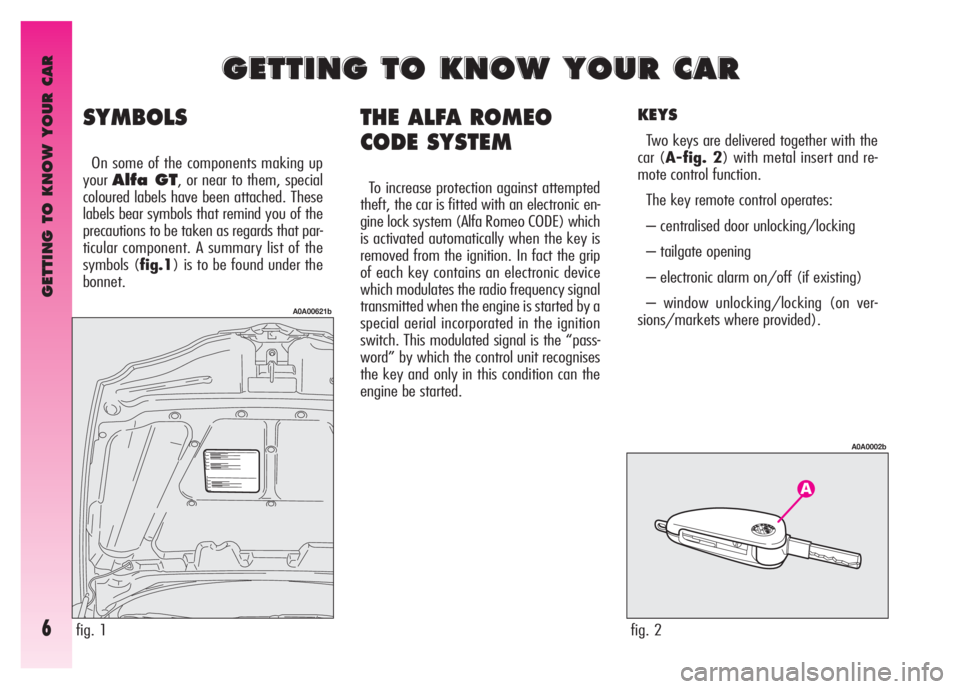
GETTING TO KNOW YOUR CAR
6
THE ALFA ROMEO
CODE SYSTEM
To increase protection against attempted
theft, the car is fitted with an electronic en-
gine lock system (Alfa Romeo CODE) which
is activated automatically when the key is
removed from the ignition. In fact the grip
of each key contains an electronic device
which modulates the radio frequency signal
transmitted when the engine is started by a
special aerial incorporated in the ignition
switch. This modulated signal is the “pass-
word” by which the control unit recognises
the key and only in this condition can the
engine be started.
KEYS
Two keys are delivered together with the
car (A-fig. 2) with metal insert and re-
mote control function.
The key remote control operates:
– centralised door unlocking/locking
– tailgate opening
– electronic alarm on/off (if existing)
– window unlocking/locking (on ver-
sions/markets where provided).
G G
E E
T T
T T
I I
N N
G G
T T
O O
K K
N N
O O
W W
Y Y
O O
U U
R R
C C
A A
R R
fig. 2
A0A0002b
fig. 1
A0A00621b
SYMBOLS
On some of the components making up
your
Alfa GT, or near to them, special
coloured labels have been attached. These
labels bear symbols that remind you of the
precautions to be taken as regards that par-
ticular component. A summary list of the
symbols (fig.1) is to be found under the
bonnet.
Page 13 of 271
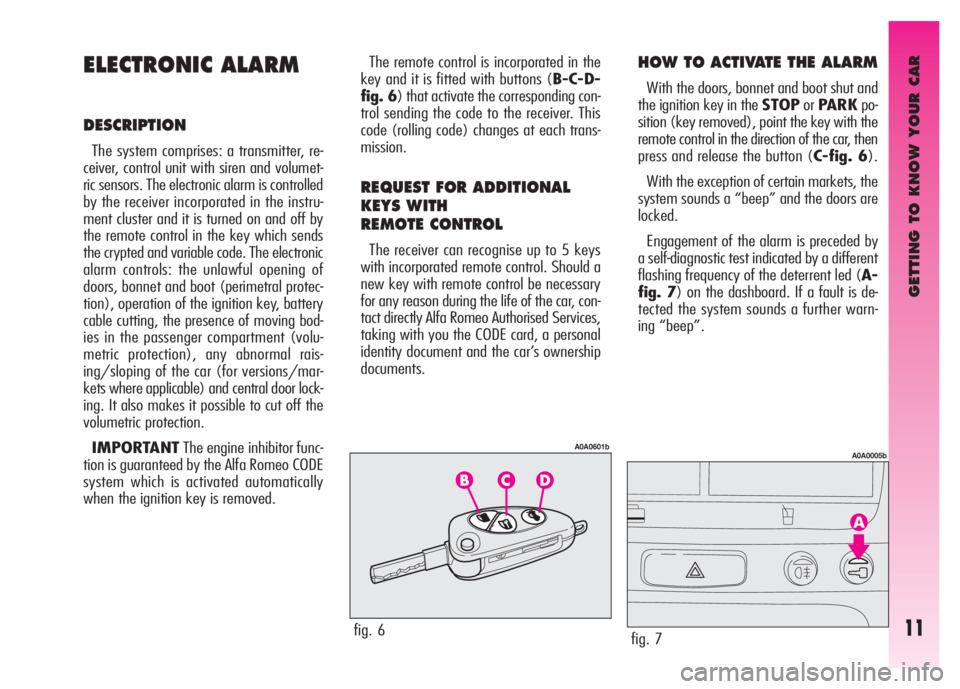
GETTING TO KNOW YOUR CAR
11
ELECTRONIC ALARM
DESCRIPTION
The system comprises: a transmitter, re-
ceiver, control unit with siren and volumet-
ric sensors. The electronic alarm is controlled
by the receiver incorporated in the instru-
ment cluster and it is turned on and off by
the remote control in the key which sends
the crypted and variable code. The electronic
alarm controls: the unlawful opening of
doors, bonnet and boot (perimetral protec-
tion), operation of the ignition key, battery
cable cutting, the presence of moving bod-
ies in the passenger compartment (volu-
metric protection), any abnormal rais-
ing/sloping of the car (for versions/mar-
kets where applicable) and central door lock-
ing. It also makes it possible to cut off the
volumetric protection.
IMPORTANTThe engine inhibitor func-
tion is guaranteed by the Alfa Romeo CODE
system which is activated automatically
when the ignition key is removed.The remote control is incorporated in the
key and it is fitted with buttons (B-C-D-
fig. 6) that activate the corresponding con-
trol sending the code to the receiver. This
code (rolling code) changes at each trans-
mission.
REQUEST FOR ADDITIONAL
KEYS WITH
REMOTE CONTROL
The receiver can recognise up to 5 keys
with incorporated remote control. Should a
new key with remote control be necessary
for any reason during the life of the car, con-
tact directly Alfa Romeo Authorised Services,
taking with you the CODE card, a personal
identity document and the car’s ownership
documents.
HOW TO ACTIVATE THE ALARM
With the doors, bonnet and boot shut and
the ignition key in the STOPorPARKpo-
sition (key removed), point the key with the
remote control in the direction of the car, then
press and release the button (C-fig. 6).
With the exception of certain markets, the
system sounds a “beep” and the doors are
locked.
Engagement of the alarm is preceded by
a self-diagnostic test indicated by a different
flashing frequency of the deterrent led (A-
fig. 7) on the dashboard. If a fault is de-
tected the system sounds a further warn-
ing “beep”.
fig. 6
A0A0601b
fig. 7
A0A0005b
Page 14 of 271
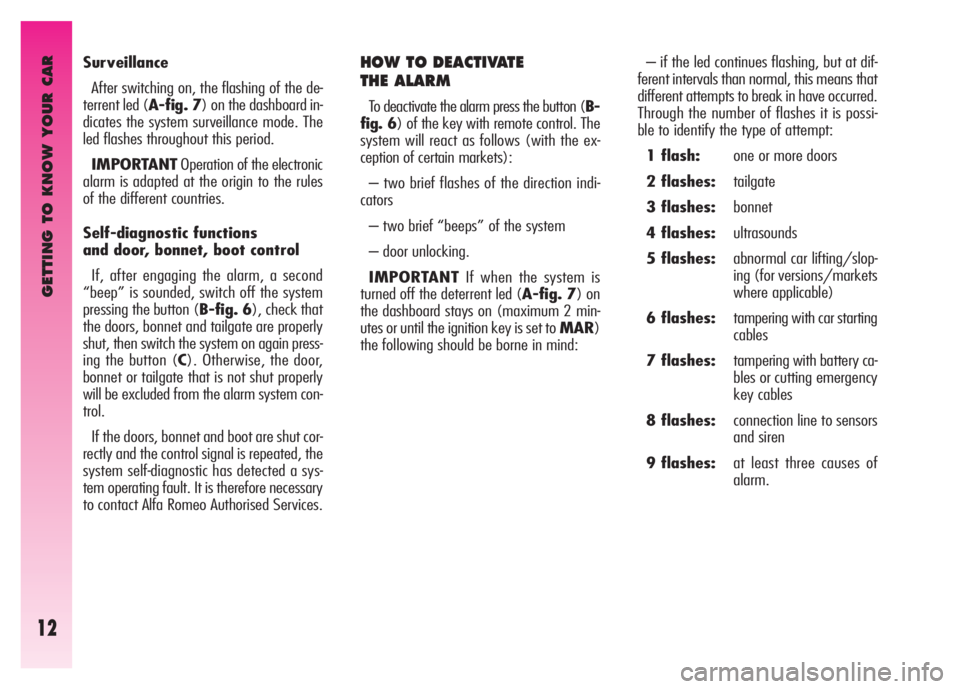
GETTING TO KNOW YOUR CAR
12
– if the led continues flashing, but at dif-
ferent intervals than normal, this means that
different attempts to break in have occurred.
Through the number of flashes it is possi-
ble to identify the type of attempt:
1 flash:one or more doors
2 flashes:tailgate
3 flashes:bonnet
4 flashes:ultrasounds
5 flashes:abnormal car lifting/slop-
ing (for versions/markets
where applicable)
6 flashes:tampering with car starting
cables
7 flashes:tampering with battery ca-
bles or cutting emergency
key cables
8 flashes:connection line to sensors
and siren
9 flashes:at least three causes of
alarm. Surveillance
After switching on, the flashing of the de-
terrent led (A-fig. 7) on the dashboard in-
dicates the system surveillance mode. The
led flashes throughout this period.
IMPORTANTOperation of the electronic
alarm is adapted at the origin to the rules
of the different countries.
Self-diagnostic functions
and door, bonnet, boot control
If, after engaging the alarm, a second
“beep” is sounded, switch off the system
pressing the button (B-fig. 6), check that
the doors, bonnet and tailgate are properly
shut, then switch the system on again press-
ing the button (C). Otherwise, the door,
bonnet or tailgate that is not shut properly
will be excluded from the alarm system con-
trol.
If the doors, bonnet and boot are shut cor-
rectly and the control signal is repeated, the
system self-diagnostic has detected a sys-
tem operating fault. It is therefore necessary
to contact Alfa Romeo Authorised Services.HOW TO DEACTIVATE
THE ALARM
To deactivate the alarm press the button (B-
fig. 6) of the key with remote control. The
system will react as follows (with the ex-
ception of certain markets):
– two brief flashes of the direction indi-
cators
– two brief “beeps” of the system
– door unlocking.
IMPORTANTIf when the system is
turned off the deterrent led (A-fig. 7) on
the dashboard stays on (maximum 2 min-
utes or until the ignition key is set to MAR)
the following should be borne in mind:
Page 15 of 271
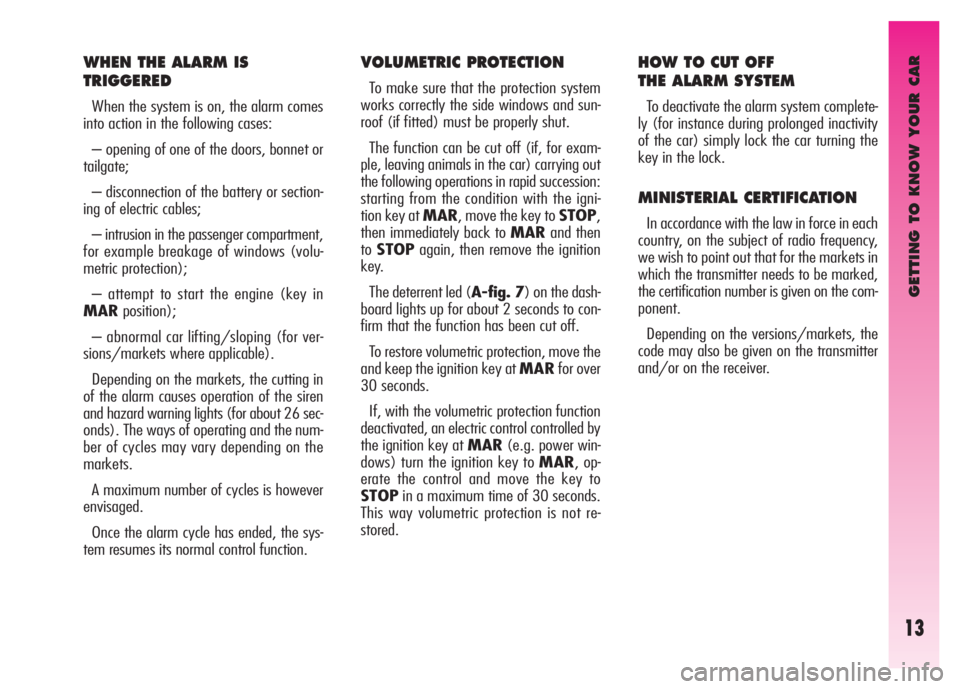
GETTING TO KNOW YOUR CAR
13
WHEN THE ALARM IS
TRIGGERED
When the system is on, the alarm comes
into action in the following cases:
– opening of one of the doors, bonnet or
tailgate;
– disconnection of the battery or section-
ing of electric cables;
– intrusion in the passenger compartment,
for example breakage of windows (volu-
metric protection);
– attempt to start the engine (key in
MARposition);
– abnormal car lifting/sloping (for ver-
sions/markets where applicable).
Depending on the markets, the cutting in
of the alarm causes operation of the siren
and hazard warning lights (for about 26 sec-
onds). The ways of operating and the num-
ber of cycles may vary depending on the
markets.
A maximum number of cycles is however
envisaged.
Once the alarm cycle has ended, the sys-
tem resumes its normal control function.
VOLUMETRIC PROTECTION
To make sure that the protection system
works correctly the side windows and sun-
roof (if fitted) must be properly shut.
The function can be cut off (if, for exam-
ple, leaving animals in the car) carrying out
the following operations in rapid succession:
starting from the condition with the igni-
tion key at MAR, move the key to STOP,
then immediately back to MARand then
toSTOPagain, then remove the ignition
key.
The deterrent led (A-fig. 7) on the dash-
board lights up for about 2 seconds to con-
firm that the function has been cut off.
To restore volumetric protection, move the
and keep the ignition key at MARfor over
30 seconds.
If, with the volumetric protection function
deactivated, an electric control controlled by
the ignition key at MAR(e.g. power win-
dows) turn the ignition key to MAR, op-
erate the control and move the key to
STOPin a maximum time of 30 seconds.
This way volumetric protection is not re-
stored.
HOW TO CUT OFF
THE ALARM SYSTEM
To deactivate the alarm system complete-
ly (for instance during prolonged inactivity
of the car) simply lock the car turning the
key in the lock.
MINISTERIAL CERTIFICATION
In accordance with the law in force in each
country, on the subject of radio frequency,
we wish to point out that for the markets in
which the transmitter needs to be marked,
the certification number is given on the com-
ponent.
Depending on the versions/markets, the
code may also be given on the transmitter
and/or on the receiver.
Page 54 of 271
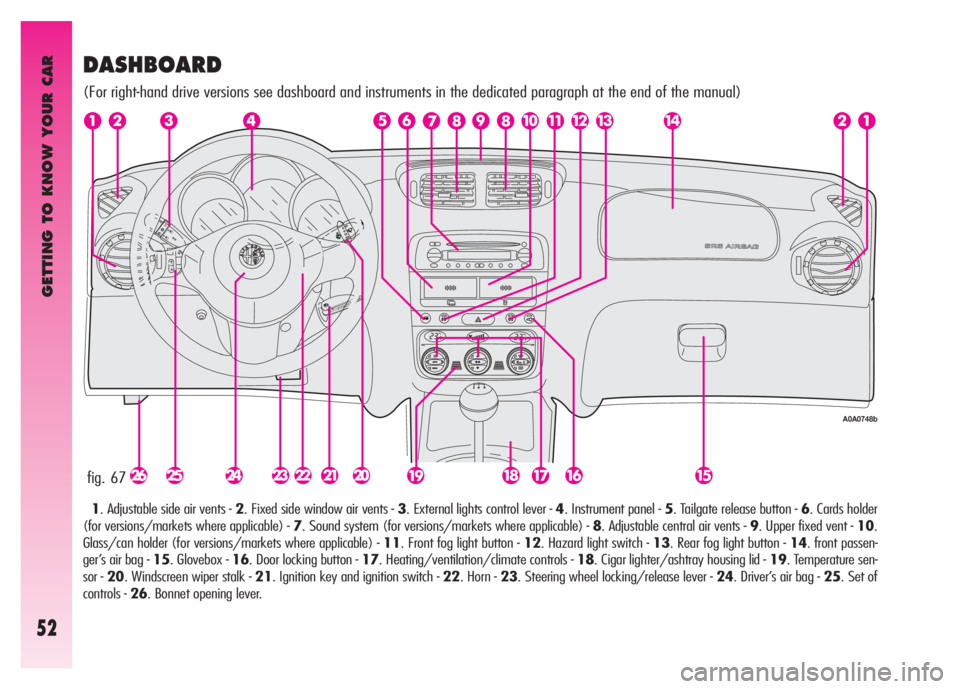
GETTING TO KNOW YOUR CAR
52
fig. 67
A0A0748b
DASHBOARD
(For right-hand drive versions see dashboard and instruments in the dedicated paragraph at the end of the manual)
1. Adjustable side air vents - 2. Fixed side window air vents - 3. External lights control lever - 4. Instrument panel - 5. Tailgate release button - 6. Cards holder
(for versions/markets where applicable) - 7. Sound system (for versions/markets where applicable) - 8. Adjustable central air vents - 9. Upper fixed vent - 10.
Glass/can holder (for versions/markets where applicable) - 11. Front fog light button - 12. Hazard light switch - 13. Rear fog light button - 14. front passen-
ger’s air bag - 15. Glovebox - 16. Door locking button - 17. Heating/ventilation/climate controls - 18. Cigar lighter/ashtray housing lid - 19. Temperature sen-
sor - 20. Windscreen wiper stalk - 21. Ignition key and ignition switch - 22. Horn - 23. Steering wheel locking/release lever - 24. Driver’s air bag - 25. Set of
controls - 26. Bonnet opening lever.
Page 76 of 271
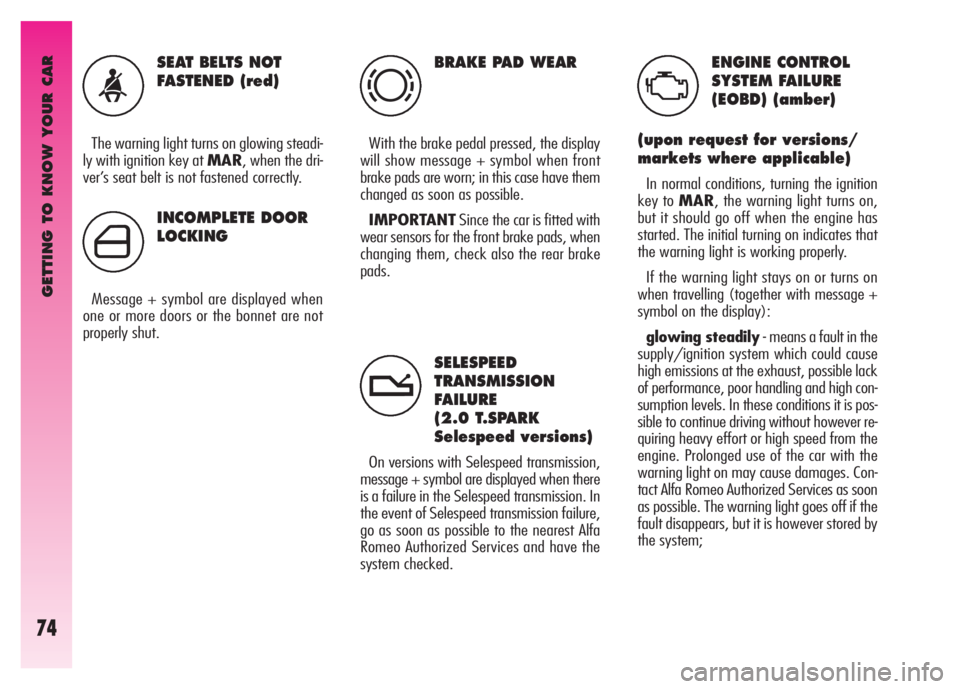
GETTING TO KNOW YOUR CAR
74
BRAKE PAD WEAR
With the brake pedal pressed, the display
will show message + symbol when front
brake pads are worn; in this case have them
changed as soon as possible.
IMPORTANTSince the car is fitted with
wear sensors for the front brake pads, when
changing them, check also the rear brake
pads.
SELESPEED
TRANSMISSION
FAILURE
(2.0 T.SPARK
Selespeed versions)
On versions with Selespeed transmission,
message + symbol are displayed when there
is a failure in the Selespeed transmission. In
the event of Selespeed transmission failure,
go as soon as possible to the nearest Alfa
Romeo Authorized Services and have the
system checked.
ENGINE CONTROL
SYSTEM FAILURE
(EOBD) (amber)
(upon request for versions/
markets where applicable)
In normal conditions, turning the ignition
key to MAR, the warning light turns on,
but it should go off when the engine has
started. The initial turning on indicates that
the warning light is working properly.
If the warning light stays on or turns on
when travelling (together with message +
symbol on the display):
glowing steadily- means a fault in the
supply/ignition system which could cause
high emissions at the exhaust, possible lack
of performance, poor handling and high con-
sumption levels. In these conditions it is pos-
sible to continue driving without however re-
quiring heavy effort or high speed from the
engine. Prolonged use of the car with the
warning light on may cause damages. Con-
tact Alfa Romeo Authorized Services as soon
as possible. The warning light goes off if the
fault disappears, but it is however stored by
the system;
SEAT BELTS NOT
FASTENED (red)
The warning light turns on glowing steadi-
ly with ignition key at MAR, when the dri-
ver’s seat belt is not fastened correctly.
INCOMPLETE DOOR
LOCKING
Message + symbol are displayed when
one or more doors or the bonnet are not
properly shut.
t
U
Page 133 of 271

GETTING TO KNOW YOUR CAR
131fig. 147
A0A0707b
Carry out this operation
only with the car station-
ary.
DANGER-SERIOUS IN-
JURY. When carrying out
checks or maintenance op-
erations in the engine compart-
ment, take special care not to bump
the head on the raised bonnet.
If checks need to be car-
ried out in the engine com-
partment when the engine
is still warm, keep away from the
fan as it could start up even when
the key is removed from the igni-
tion. Wait until the engine cools
down.
BONNET
The bonnet opening lever is under the left
end of the dashboard.
To open:
– pull the lever (A-fig. 146) until the
bonnet clicks open.
– press the safety lever (A-fig. 147)
upwards.
– raise the bonnet.
IMPORTANTBonnet raising is aided by
two gas springs. Do not tamper with these
springs and accompany the bonnet while
raising it.
fig. 146
A0A0135b
Scarves, ties and loose
clothing may be caught in
the moving parts.
For safety reasons the
bonnet must be closed
properly to avoid its open-
ing while the car is travelling.
Therefore, always check it is prop-
erly closed and the catch engaged.
Should you notice that the catch is
not perfectly engaged when trav-
elling, stop the car immediately and
close the bonnet.
To close:
– lower the bonnet until approx. 20 cm
from the engine compartment and then let
it drop, ensuring it is fully closed and not just
held in position by the safety catch.
If the bonnet does not close properly do
not push it down but open it again and re-
peat the above procedure.
Page 219 of 271

CAR MAINTENANCE
217
SCHEDULED MAINTENANCE PROGRAMME
20 40 60 80 100 120 140 160 180Thousands of km
Check tyre conditions/wear and adjust pressure if necessary
Check operation of lighting system (headlights, direction indicators,
hazard warning lights, boot, passenger compartment, glovebox lights, warning lights, etc..)
Check operation of windscreen washer system, adjust spray jets
Check position/wear of windscreen/rearscreen wiper blades
Check operation of front disk brake pad wear indicator
Check wear conditions of rear disk brake pads
Sight check the conditions of: body exterior, underbody protection, stiff pipes
and hoses (exhaust - fuel supply - brakes), rubber parts
(boots - sleeves - bushes etc..)
Check cleanness of locks, bonnet and boot and lever cleanness, and lubrication
Sight inspect accessory drive belt conditions
Check handbrake lever stroke adjustment
Check antievaporation system (petrol versions)
Change air cleaner cartridge (petrol versions)
Change air cleaner cartridge (JTD versions)
Top up fluid levels (engine coolant, brakes, windscreen washer, battery, etc..)
●●●●●●●●●
●●●●●●●●●
●●●●●●●●●
●●●●●●●●●
●●●●●●●●●
●●●●
●●●●●●●●●
●●●●●●●●●
●●
●●●●
●●
●●●●
●●●●●●●●●
●●●●●●●●●
Page 221 of 271
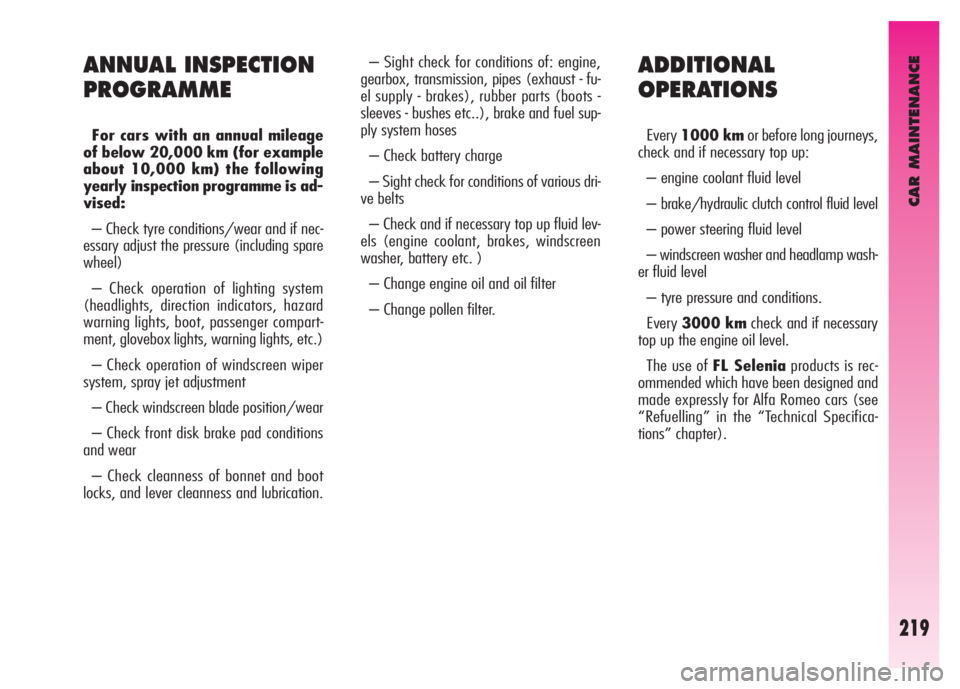
CAR MAINTENANCE
219
ADDITIONAL
OPERATIONS
Every 1000 kmor before long journeys,
check and if necessary top up:
– engine coolant fluid level
– brake/hydraulic clutch control fluid level
– power steering fluid level
– windscreen washer and headlamp wash-
er fluid level
– tyre pressure and conditions.
Every 3000 kmcheck and if necessary
top up the engine oil level.
The use of FL Seleniaproducts is rec-
ommended which have been designed and
made expressly for Alfa Romeo cars (see
“Refuelling” in the “Technical Specifica-
tions” chapter).
ANNUAL INSPECTION
PROGRAMME
For cars with an annual mileage
of below 20,000 km (for example
about 10,000 km) the following
yearly inspection programme is ad-
vised:
– Check tyre conditions/wear and if nec-
essary adjust the pressure (including spare
wheel)
– Check operation of lighting system
(headlights, direction indicators, hazard
warning lights, boot, passenger compart-
ment, glovebox lights, warning lights, etc.)
– Check operation of windscreen wiper
system, spray jet adjustment
– Check windscreen blade position/wear
– Check front disk brake pad conditions
and wear
– Check cleanness of bonnet and boot
locks, and lever cleanness and lubrication.– Sight check for conditions of: engine,
gearbox, transmission, pipes (exhaust - fu-
el supply - brakes), rubber parts (boots -
sleeves - bushes etc..), brake and fuel sup-
ply system hoses
– Check battery charge
– Sight check for conditions of various dri-
ve belts
– Check and if necessary top up fluid lev-
els (engine coolant, brakes, windscreen
washer, battery etc. )
– Change engine oil and oil filter
– Change pollen filter.
Page 234 of 271

CAR MAINTENANCE
232
Proceed as follows with doors closed:
1.open completely the driver’s window
keeping the button pressedfor at
least 3 seconds after full opening;
2.close completely the driver’s window
keeping the button pressedfor at
least 3 seconds after full closing;
3.proceed as described in points 1 and
2 also for the passenger’s side;
4.check for proper initialisation by oper-
ating the windows in automatic.
USEFUL HINTS TO EXTEND
THE LIFE OF YOUR BATTERY
To avoid rapidly draining the battery and
ensure that it continues to work correctly,
the following should be noted:
– The terminals must always be firmly
tightened.
– As far as possible, avoid keeping ser-
vices on for a long time with the engine
stopped (radio, hazard lights, parking lights,
etc.). IMPORTANTIf the battery is kept with
a charge of below 50% it is damaged by sul-
phation, its starting capability is reduced and
it is also more subject to the possibility of
freezing (this may occur already at -10 °C).
In the event of a prolonged inactivity, refer
to the paragraph “car inactivity”, in the
chapter “Correct use of the car”.
CHANGING
THE BATTERY
When changing the battery it should be re-
placed with another original one with the
same characteristics. If it is replaced by a
battery with different characteristics, the
maintenance intervals given in the Sched-
uled Maintenance Programme in this chap-
ter are no longer valid and for maintenance
it will be necessary to follow the battery
Manufacturer’s instructions.
IMPORTANTLacking power to control
units (e.g. battery change/disconnection
and replacement of power window control
unit protection fuses), window automatism
must be reset.– When leaving the car parked in a
garage, make sure that the doors, bonnet,
boot and interior lids are properly shut to
prevent lights from staying on.
– Before carrying out any work on the
electric system, disconnect the negative ca-
ble from the battery.
– If after buying the car, you wish to in-
stall electric accessories which require a per-
manent electric supply (alarm, voice feature,
radionavigator with satellite antitheft func-
tion etc.) or accessories that burden the elec-
tric system, contact Alfa Romeo Authorised
Services whose qualified personnel, in ad-
dition to suggesting the most suitable de-
vices belonging to Lineaccessori Alfa Romeo,
will evaluate the overall electric absorption,
checking whether the car’s electric system
is capable of withstanding the load required,
or whether it should be integrated with a
more powerful battery. In fact, as some of
these devices continue absorbing energy
even when the ignition key is off (car sta-
tionary, engine off), they gradually drain the
battery.